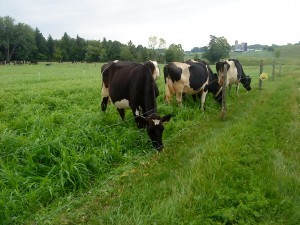Originally posted on June 3, 2015 on the Vermont Pasture Network Blog
Getting ready for mid-summer dry weather for your grazing animals? Pearl millet may be a great annual option because of its incredible resiliency.
Pearl millet or Millet [Pennisetum americanum (L.) R. Br. is a warm season annual grass that is well-adapted to fertile soils. With proper management millet can easily yield around 10 ton of forage to the acre, right when cool-season forages nearly stop growing due to hydric stress. Millet has an excellent quality, with low tannins and high protein, calcium, phosphorus and digestibility levels. Additionally, preliminary [non-conclusive] results of a study conducted in Vermont evidence that its fatty acid profile is similar to that of the diverse cool-season forages in the Northeastern U.S. These benefits show up in the milk or meat of animals that graze it, delivering excellent health benefits.

Many more photos of millet at different times in the growing season are available with the original post: http://blog.uvm.edu/pasture-vtpasture/2015/06/03/when-planning-for-the-summer-slump-consider-pearl-millet/
Millet loves heat and it is drought tolerant but can endure wet soils. It must be established in early summer (by the end of May, beginning of June), at the average rate of 20 pounds per acre. It can be potentially ready to be grazed around mid-July on. If carefully managed, it can yield two or even three grazing rotations until the first frost.
Millet can be used for grazing, hay, silage or green-chop. Pasture management research and observation recommends to start grazing millet before boot stage, when it reaches between 18 and 24 inches high, leaving about 10 to 12 inches of residue. Millet can take a lot of grazing pressure and animals must be allowed to graze a paddock for a few hours per day or, rotated as many times as needed per day. The use of strip-grazing with a back fence is strongly recommended to promote faster re-growth while avoiding damaging it.Prussic acid is not a concern in Pearl Millet but nitrate poisoning can be a problem if, a) high nitrogen fertilization rates are applied, b) prolonged droughts are followed by rain; and c) encountering any condition that kills the plant but not the roots such as, frost, hail, grazing and trampling, etc.
In a study we conducted during 2014 at a farm in Highgate, Vermont, we drilled 7 acres of millet on a beaten “sacrifice” paddock. Millet was exposed to different levels of grazing pressure: light, medium and heavly grazed. In each condition, its re-growth was impressively vigorous, even when plants looked heavily grazed and with little chances of recovering.
So, when planning your next cover crop give Pearl Millet a try!
You can find more resources about pearl millet below:
Juan Alvez, Ph.D., Pasture Program Technical Coordinator
Have you explored different successful forage ideas to overcome the summer slump and have a more uniform livestock production along the season? You can share your observations by dropping us a line at the UVM Center for Sustainable Agriculture Pasture Program: Juan Alvez (jalvez@uvm.edu); Kimberly Hagen (kimberly.hagen@uvm.edu) and, Jennifer Colby (jcolby@uvm.edu)
*Any reference to commercial products, trade names, websites or brand names is for information only, and no endorsement or approval is intended.